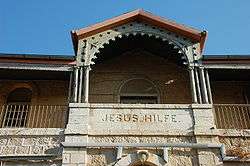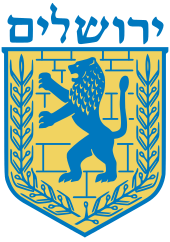Talbiya

Talbiya or Talbiyeh (Arabic: الطالبية, Hebrew: טלביה), officially Komemiyut, is an upscale neighborhood in Jerusalem, located between Rehavia and Katamon. It was built in the 1920s and 1930s on land purchased from the Greek Patriarchate. Most of the early residents were affluent Middle Eastern Christians who built elegant homes with Renaissance, Moorish and Arab architectural motifs, surrounded by trees and flowering gardens.[1]
History
After World War I, Constantine Salameh, a native of Beirut, bought land in Talbiya from the Greek Orthodox Patriarchate with the idea of building a prestigious neighborhood for Middle Eastern Christians. In addition to a villa for himself, Salameh built two apartment houses on the square that was named for him.[2] After the 1948 Palestine war many Arab residents of Talbiya lost the right to their properties due to Israel's Absentee Property Law. After a long legal process, Salameh was paid a symbolic $700,000 in compensation for his multimillion-dollar properties located in Israel because he had proved that he had not left the Palestine Mandate due to the conflict, rather he was on a business trip during the outbreak of hostilities.[2] Talbiya's Gan Hashoshanim (Rose Garden) dates back to the 1930s. After the establishment of the State of Israel, official Independence Day events were held at this park.

Before the Six-Day War, many of the villas in Talbiya housed foreign consulates. The home of Constantine Salameh, which he leased to the Belgian consulate, faces a flowering square, originally Salameh Square, later renamed Wingate Square to commemorate Orde Wingate, a British officer who trained members of the Haganah in the 1930s. Marcus Street is named for Colonel David (Mickey) Marcus, an officer in the U.S. army who volunteered to be a military advisor in Israel’s War of Independence.[1]
Today
The neighborhood's Hebrew name Komemiyut, (קוממיות) introduced after the establishment of the state, never caught on, and it is still known as Talbiya.[3] Some of Jerusalem's important cultural institutions are located in Talbiya, among them the Jerusalem Theater, the Van Leer Institute and Beit HaNassi, the official residence of the President of Israel.
Notable residents
Coordinates: 31°46′N 35°13′E / 31.767°N 35.217°E
References
| Wikimedia Commons has media related to Talbiya. |
- 1 2 Eylon, Lili (2011). "Jerusalem: Architecture in the British Mandate Period". Jewish Virtual Library. Retrieved 18 December 2011.
- 1 2 "Villa Dolorosa: The story of Villa Salameh, one of the most impressive buildings in Jerusalem, is a tale of a passion for beauty and luxury, of Palestinian emigration and loss, and of a titanic battle for its ownership". Haaretz. 8 January 2003. Retrieved 18 December 2011.
- ↑ "A stir over sign language: A recently discovered trove of documents from the 1950s reveals a nasty battle in Jerusalem over the hebraization of street and neighborhood names. This campaign is still raging today.". Haaretz. 29 July 2011. Retrieved 18 December 2011.
